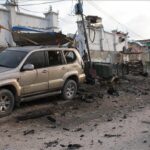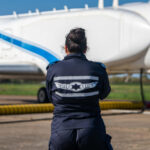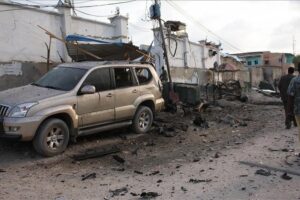A large contingent of U.S. paratroopers is expected to jump into Estonia tonight after a long flight from Fort Bragg, North Carolina, that includes mid-air refueling.
The jump is one of three brigade-size jumps over the next several days in which a total of 7,000 paratroopers from the United States and 10 other nations will conduct a joint forcible entry exercise at each of the landing sites in Estonia, Bulgaria and Romania.
The exercise, known as Swift Response, is part of a larger umbrella exercise called Defender Europe 2021 that runs from May through mid-June and spans countries from the Baltic region to Morocco, with U.S. Army Europe and Africa coordinating missions across the continent.
Maj. Gen. Chris Donahue, 82nd Airborne Division commander, said everyone participating in the exercise has received the COVID-19 vaccination.
A large contingent of U.S. paratroopers is expected to jump into Estonia tonight after a long flight from Fort Bragg, North Carolina, that includes mid-air refueling.
The jump is one of three brigade-size jumps over the next several days in which a total of 7,000 paratroopers from the United States and 10 other nations will conduct a joint forcible entry exercise at each of the landing sites in Estonia, Bulgaria and Romania.
The exercise, known as Swift Response, is part of a larger umbrella exercise called Defender Europe 2021 that runs from May through mid-June and spans countries from the Baltic region to Morocco, with U.S. Army Europe and Africa coordinating missions across the continent.
Maj. Gen. Chris Donahue, 82nd Airborne Division commander, said everyone participating in the exercise has received the COVID-19 vaccination.
“This is a good example of how you can train as we work through this pandemic,” Donahue said.
Last year’s Defender Europe 20 was significantly reduced, as it coincided with the early outbreak and spread of the virus.
An estimated 800 paratroopers with the 82nd Airborne Division’s 3rd Brigade Combat Team will parachute into Estonia Friday night, weather permitting. About half will make the 11-hour flight directly from Bragg. The rest of the 82nd paratroopers are staged in Lithuania and will meet up in the air with the Bragg soldiers to make the jump.
Soon after, 1,050 of their counterparts at the Army’s 173rd Airborne Brigade out of Vicenza, Italy, will take off from an area in Hungary and drop into Bulgaria overnight May 9-10. Then, 40 U.S soldiers will jump into Romania May 10 with 350 paratroopers from Poland’s 6th Airborne Brigade, under the 82nd’s control.
After they land, the paratroopers will rally with their respective units, collect their gear, which includes air-dropped vehicles, artillery and supplies, then conduct an assault against Estonian soldiers acting as an opposition force.
Air Force C-17 aircrews, loadmasters and air refueling crews will be among the airmen helping the Army get to where they need to be, with the equipment they need to carry out their mission.
Even for some experienced soldiers, an exercise at this scale is unique.
“Some of the commanders have only jumped on Fort Bragg,” said Lt. Col. Mike Burns, a division spokesman.
The 82nd sent a two-battalion task force with a brigade command post and a larger division command post to control the three brigades across the continent, Burns said.
The effort involving three brigades is somewhat unusual. In the recent past, such jumps have been done only at the battalion level, which would include perhaps 600 to 700 paratroopers per jump. And the last time the 82nd Airborne flew paratroopers from Fort Bragg to Europe nonstop for a jump was in Swift Response 2018, according to an Army statement.
For that run, they dropped into Lithuania and Latvia along with partner paratroopers from nine other countries.
Maj. Ben Barnard, who planned the drill. told Army Times that while there have been past efforts at the battalion level, the way the Army expects to operate alongside NATO or other allies in potential future conflicts brings larger elements into play.
“To do that at the operational level with the division, with U.S. Army Europe as a headquarters, at scale, becomes quite complex to integrate,” he said.

Simulations and backyard rehearsals at Fort Bragg are useful, but can’t give planners, commanders and soldiers a real feel for such an operation until they’ve confronted all of the real-world burdens of moving so many soldiers and so much equipment.
For paratroopers, this is an enlistment-defining experience, Barnard said. They’ll be able to say they were part of one of the largest airborne operations in recent years.
Even though the entire group of soldiers leaving the United States for the exercise has been vaccinated, they’ll still follow protocols such as mask wearing and distancing. The majority of their work will be outdoors.
Lt. Col. Jonathan Pederson, division surgeon for the 82nd, noted that division soldiers will be traveling in groups and maintaining bubbles. But the division was going ahead with plans for some version of the exercise months ago, before the vaccines were approved in December.
Having those vaccines roll out in the following weeks helped planners identify who could go on the exercise and prioritize personnel for the training, Bedford said.















